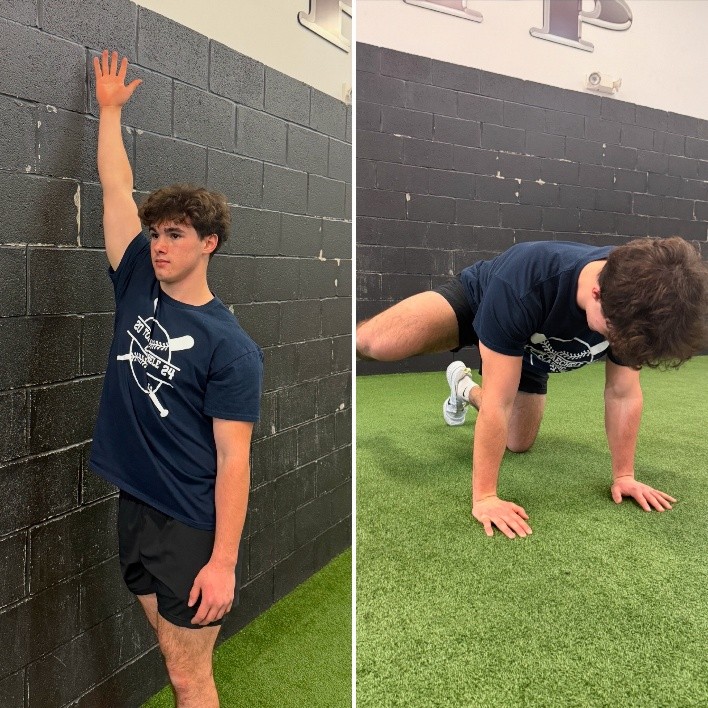
Putting your foot up on a table and stretching out your hamstring might feel good and can give you some temporary relief if done for long enough and frequently, but this newfound “Passive” range-of-motion (ROM) will more than likely NOT transfer to game play. This, requires what we call “Active” ROM.
Why? Let’s get into it…
Now, don’t get me wrong, Passive / static ROM exercises have their place. For example, I’ll be the first to tell you that we prescribe hip flows (see below) to our athletes all the time to get loose for either a lift or a pen. But I’ll also be the first to tell you that this is not the whole picture when it comes to improving hip mobility, long-term.
Hip Flow Circuit
The hip and shoulder mobility we are addressing in today’s discussion is active mobility. This refers to the amount of active, usable motion that one possesses
“The more active mobility a person has, the more they can maximize their movement potential safely, efficiently, and effectively.”
Passive vs Active Range of Motion
So, what is the difference between Passive and Active mobility?
When training to improve joint mobility, the goal should be to improve an active range of motion. Let’s talk briefly about the difference between “Passive” and “Active” range of motion.
Passive ROM – This is the distance a joint can be moved by an outside force, like a physical therapist or S&C coach. The athlete being moved doesn’t use their own muscles to move the joint typically due to injury, or pain. It can also be used to assess the full range of motion of a joint.
Passive ROM
Active ROM – This is the distance a joint can be moved when you use your own muscles to actively contract and relax through its full range, thereby enhancing flexibility, muscle strength, and joint function.
We never want to see an athlete with a lot of Passive ROM that they can’t control actively. Thus, we will test both Passive and Active internal ROM and assess the difference.
Active ROM
An acceptable difference between Passive and Active internal rotation is typically around 10-20 degrees; meaning that the Passive range of motion (where the joint is moved by a trainer or PT) should be noticeably greater than the Active range of motion (where the athlete moves the joint on their own) by about 10-20 degrees.
However, if the “Passive” difference is greater than 20 degrees, this is where directly prescribing some good Motor Control training in IR and ER can be really effective for both the hips and shoulders.
Motor Control
Now the next question “What is motor control?”
Motor control is the ability of the nervous system to regulate and coordinate posture and muscle activation, to produce purposeful and coordinated movements in response to sensory information from the body’s sensory organs called “mechanoreceptors”. These are sensory organs that respond to mechanical stimuli and act as mini informants to the central nervous system (CNS).
Note: Poor Motor Control is more common in younger athletes due primarily to a lack of strength within the ROM as well as the rapid rate that they are growing which makes co-ordination (motor control) all the more difficult.
Functional Range Systems
Functional Range System (FRS) is the brainchild of Dr. Andreo Spina and became very popular in the rehab and sports medicine world quite a few years ago.
The concept behind FRS is that in order to achieve mobility that will stick, the muscle, tendon, or a ligament needs to be placed under stress to help stimulate these mechanoreceptors and in turn remodel the tissue being addressed.
To help create more motor control, Dr. Spina developed Controlled Articular Rotations (CARS). They are used to help relay multidirectional and rotatory information from the mechanoreceptors. More stimulus to these mechanoreceptors means more afferent feedback to the CNS and the musculoskeletal system, ultimately inducing more active control and more efficient movement.
CARS require actively moving through the athlete’s available ROM while under muscular control. This is done by creating resistance through the air (see video below). In each set, try to create a larger “circle” to improve control on the outer limits of the athlete’s range, thus enhancing the adaptability of the tissue and aiding in joint health, integrity, and protection.
Hip CARS
These same principles and techniques are applied to the shoulder.
Shoulder CARS
Summary
Passive range of motion can be great when assessing an athlete or simply to warm up a joint prior to a lift. However, Active ROM as is the concept of FRS is that to achieve mobility that will stick, the muscle, tendon, or a ligament, needs to be placed under stress to help stimulate mechanoreceptors and in turn remodel the tissue being addressed. Utilizing Active ROM with hip and shoulder CARS is a much more efficient choice than Passive ROM/static stretching when creating useable mobility in sports performance.
See ya’ in the gym…
By Nunzio Signore (BA, CSCS, CPT, NASM, FMS)
If you’d like to be placed on our email list please enter your email address below!
